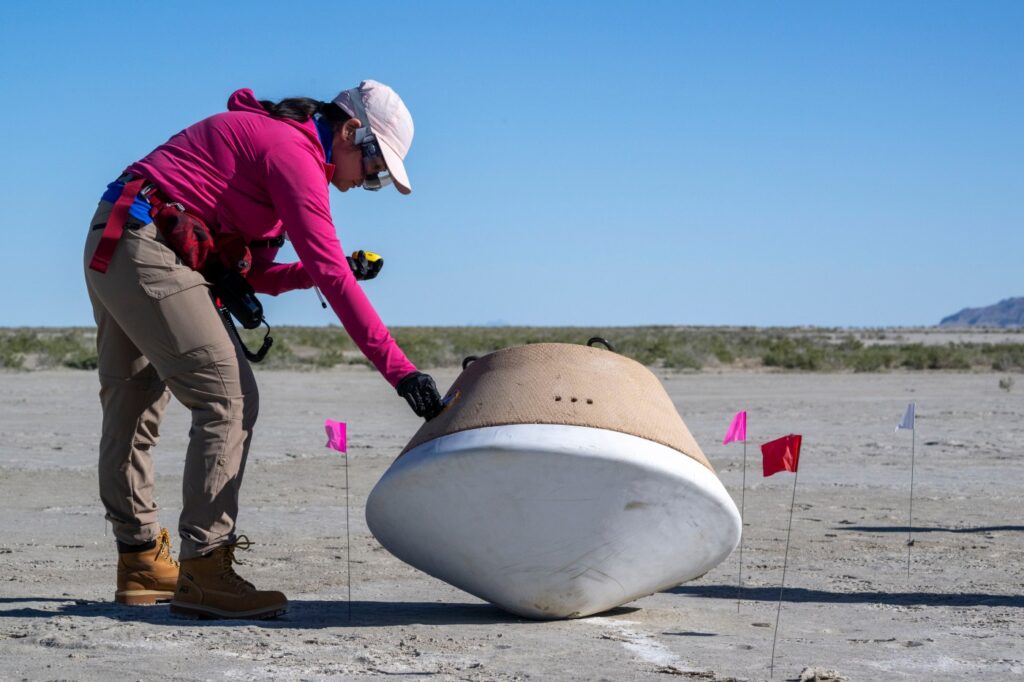As a primordial space rock hurtles toward Earth on Sunday morning, it will be protected by a heat shield invented in Silicon Valley. The priceless rock, grabbed by the OSIRIS-REx spacecraft from the distant asteroid Bennu, will face searing heat as it enters the Earth’s atmosphere at 27,650 mph. It is expected to fly over the Bay Area around 7:42 a.
m. and land in Utah’s Great Salt Lake Desert around 7:55 a. m.
, where it will be greeted by teams of scientists. Without protection, “it would all burn up, and we’d lose everything of scientific value,” said aerospace engineer Todd White of NASA’s Ames Research Center, a Sunnyvale resident who helped design the thermal protection system for the capsule. The metallic material — lighter than water, with yellow and brown streaks — was designed in specialized wind tunnels, where air gets heat-blasted by a lightning-like arc of electricity, at NASA’s Mountain View facility.
The OSIRIS-REx project, managed by NASA’s Goddard Space Flight Center and built by Lockheed Martin near Denver, is the nation’s first effort to bring asteroid samples back to Earth. The goal of the $1. 2 billion effort is to study the asteroid’s chemical composition and weathering history.
Asteroids like Bennu are the rocky remnants of material left over from the formation of our solar system and planets about 4. 6 billion years ago. They may contain the molecular precursors to the origin of life.
To be sure, plenty of asteroid samples can be found here on Earth. Because asteroids orbit the sun in erratic elliptical loops, they often tumble, fall and disintegrate, spewing easy-to-find debris. But the only way to obtain a pristine specimen — unblemished by heat, uncontaminated by dirt — is to go out into space and get it, say scientists.
This offers additional benefits: You know exactly where the rock came from, and its geologic context. Launched from Cape Canaveral, Florida, in 2016, the OSIRIS-REx spacecraft took two years to reach Bennu, a 1,600-foot-wide asteroid that orbits between Earth and Mars. It spent another two years measuring Bennu’s mass, density and other traits.
While there, its cameras made an unhappy discovery: Instead of wide plains of sand and gravel, as expected, Bennu is a boulder-filled hellscape. This raised concerns that sample collection might be impossible. In a remarkable “touch and go” maneuver in October 2020, the spacecraft approached Bennu very slowly, shot a jet of nitrogen to dislodge some rubble and then quickly grabbed a sample.
The rock — about 8 ounces, or half a pound — was stowed in the spacecraft’s capsule. “You bump into it, taking what you need,” White said. The challenge was bringing the rock back safely.
It’s a 1. 2 billion-mile trip home. If all goes according to plan, the return capsule will separate from the spacecraft as it begins its descent to the Utah desert.
The capsule becomes a fireball — reaching 5,000 degrees Fahrenheit — because it flies so fast. While it takes two hours for a commercial plane to fly from the Bay Area to the Utah site, the capsule will cover that distance in 10 minutes. It glows so brightly that NASA can watch its return using thermal cameras.
But rather than burn and break apart, the capsule deflects and dissipates the heat. That’s because the NASA Ames heat shields don’t insulate. And they push away hot air.
In addition to the OSIRIS-REx spacecraft, this material protected NASA’s Stardust Return Capsule, which captured interstellar dust, as well as the SpaceX capsule that delivers goods to the International Space Station. The shields “are there to make sure that the spacecraft — and the valuable science payload that’s on the inside — does its job,” said White. When within a mile of the ground, a main parachute will deploy, so the capsule can land gently at the U.
S. Army Dugway Test and Training Range, about 85 miles southwest of Salt Lake City. The scientists and engineers will take buses to the recovery site.
In addition to White, NASA experts include materials scientists Mairead Stackpoole and Peter Marshall, as well as Raj Venkatapathy, the NASA Ames lead for all entry system technologies. Renowned astrochemist Scott Sandford will lead the analysis. The capsule, picked up by helicopter, will be taken to a mobile clean room nearby to remove its protective coating.
The Bennu asteroid sample will be extracted, and then shipped to NASA’s Johnson Space Center in Houston. A quarter of the sample will stay there; the rest will be divided and preserved, so scientists across the world can study it in future decades. The heat shield will have perished.
“It will be black and charred, from exposure. Crispy,” White said. “It’s designed to self-sacrifice, to protect the rest of the spacecraft.
” “That’s not sad. It’s great,” he said. “It’s a job well done.
”.
From: mercurynews
URL: https://www.mercurynews.com/2023/09/23/how-nasa-ames-is-bringing-asteroid-samples-to-earth-safe-and-sound/
